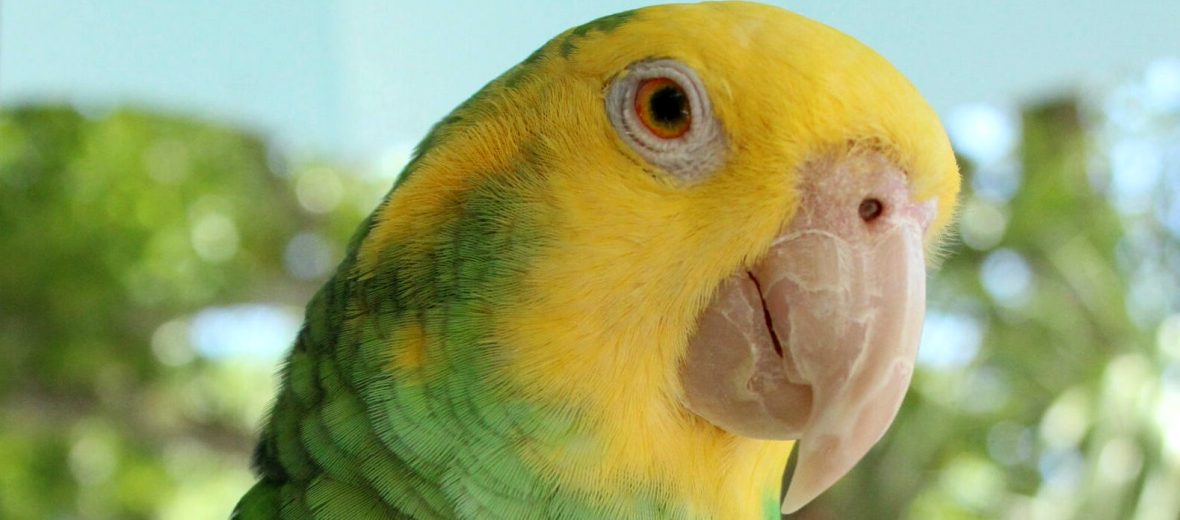
The yellow-headed Amazon parrot, aka yellow-headed parrot, yellow-headed Amazon, or double yellow-headed Amazon, calls Mexico, Belize, Guatemala, and Honduras their home. They are among the most well-known of the Amazonian parrots and popular in the exotic bird pet trade. In the wild, these birds prefer tropical and subtropical forests, mangrove swamps, coastal scrublands, and savannahs. They can also be found among cultivated land with an abundance of trees. Unfortunately, due to habitat destruction, at the hands of agriculture, housing, and urban development; hunting; trapping; and climate change, these birds have a decreasing population of a mere 4,700 estimated wild individuals. Thus, they are listed as Endangered by the IUCN.
First the Stats…
Scientific name: Amazona oratrix
Weight: Up to 1.1 lbs.
Length: Up to 14 inches
Wingspan: Up to 8.5 inches
Lifespan: Up to 80 years
Now on to the Facts!
1.) These parrots are social birds, living in flocks of up to several hundred birds.
2.) Like other Amazonian parrots, they are diurnal (active during the day).
3.) Reveling in human company, these birds are well loved pet parrots.
4.) They are intelligent and playful birds.
5.) Noisy as they are, these parrots are well-known for their good demeanor and talking abilities.
But wait, there’s more on the yellow-headed Amazon!
6.) Different from other parrots, they tend to fly silently, rather than call, while in mid-flight.
7.) But, once perched, they can be quite loud. Their usual calls are a kyaa-aa-aaah and krra-aah-aa-ow sound. They can also produce a deep, rolled ahrhrrrr or ahrrrr sound.
Did you know…?
These birds are capable of flying up to 40 mph.
8.) A group of parrots is called a company, lock, or pandemonium.
9.) Being herbivores (eat plant matter), they spend their days consuming berries, blossoms, fruits, nuts, and leaf buds. They will also frequent corn fields.
10.) The yellow-headed Amazon is monogamous (mates for life).
But wait, there’s still more on the yellow-headed Amazon!
11.) Nests are built in the hollow cavities of trees.
12.) Males will feed the female via regurgitation, while she is nesting.
Did you know…?
Parrots have around 300 taste buds located predominantly in the roof of their mouth, but also towards the back of their throat. Humans, in comparison, have up to 10,000 taste buds.
13.) Females lay up to 3 eggs, each breeding season. The eggs hatch in up to 28 days.
14.) Chicks leave the nest at around 12 weeks of age.
15.) The parrot’s green, red, and yellow pigment is formed from a pigment, called Psittacofulvins, that aids in resisting disease.
But wait, there’s still a little more on the yellow-headed Amazon!
16.) Unique in all parrots, they have the ability to use their feet to bring food to their beak, to feed.
17.) Like flamingos, these parrots will tend to stand on 1 leg, while sleeping.
18.) Bird eating snakes, like boas, prey on these parrots.
Now a Short Yellow-Headed Amazon Video!
Be sure to share & comment below! Also, check out the Critter Science YouTube channel. Videos added regularly!
Want to suggest a critter for me to write about? Let me know here.
Think you know a lot about critters? Try your hand at these fun, free quizzes:



